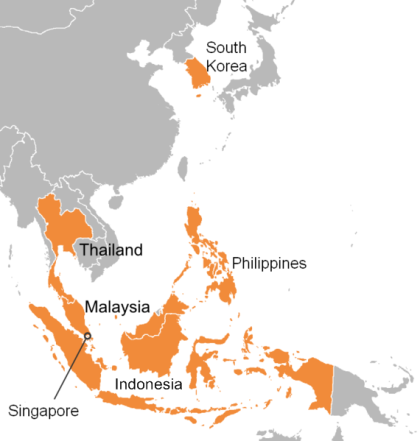In the mid-summer of 1997, much of East Asia was gripped by the Asian financial crisis. The crisis began in Thailand due to the mounting pressures of its exchange rate in the last quarter of 1996. The These mounting pressures arose from the increase of the already high current account deficits that engulfed the country at the time. Besides, there was the bursting of the of the asset price in the country and the pursuit of a fixed exchange rate in the country that aggravated the situation. Moreover, the currency experienced a huge parity with the dollar, the currency that it was pegged, leading to huge speculations about the currency, resulting in huge arbitrage profits. All these forced the Thai government to employ spot and forward exchange rates interventions, but the liquidity shortage could not be resolved, and the financial and economic collapse began spreading to neighbouring countries such as South Korea, Hong Kong, Malaysia, Singapore, Indonesia and Philippines. The collapse led to a precipitous contraction of GDP among the East Asian economies, and bankrupting companies after the overexposure to foreign currency risks. The crisis ultimately necessitated the IMF-led bailouts by the worst hit economies. The progression of the crisis led to its spill over to European and American countries, owing to effects of financial contagion.[1]
The Asian financial crisis was a confluence of various conditions that led to financial and economic turbulence that greatly magnified its devastating impacts. There exist controversies on the main causes of the Asian conflict, with some analyst arguing that the crisis was caused by the macroeconomic factors. Others argue that it was the structural weaknesses of Eastern Asia economies that predisposed the East Asian economies to the Asian Economic crisis. However, the underlying proximate causes of the crisis differ with each country, with largest portion of the blame being dished out to the greed of the international speculators.[2] According to the World Economic Outlook, there were four sets of factors that explain the Asian financial crisis: The success of these Asian economies prior to the crisis, factors within the international financial environment, the growing current accounts deficits and the structural weaknesses of the financial sectors within these economies.[3]

To briefly mention, prior to the crisis, the East Asian countries enjoyed increased growth through increased savings and investments by the private sector. Though the rates of private domestic savings were slowly rising, they were surpassed by the increased hugely increased rates of private domestic investments that were further supported by the huge foreign capital inflow. This created a current account deficit, where the rate of domestic investments surpassed the rates of domestic savings.[4] However, the current accounts deficits were in the private sector but not in the public sector. The capital inflow led to the problem of deploying them in the most efficient sector, as well as the discreet intermediation through the financial system, which were not fully developed in these economies. This was exacerbated by the short-term capital flow, which would be reversed at the slightest likelihood of troubles within the macroeconomic sector, inappropriate policies governing the exchange rate or inconsistencies or the vulnerability of the financial sector. This was the case during the 1997 crisis; the investors reversed their shorter capital flows, following the collapse of the Thai baht, which signaled a possibility of a financial crisis, thereby worsening the situation.[5]
In terms of the international environment, countries within the region had experienced weak economic performances in the first half of 1990s. The weak economy necessitated low returns on assets and low-interest rates, making investors turn to the lucrative economies in search of higher returns on their investments. The movement of funds creates a natural tendency to reverse such investments in case prospects of returns prove low than expected.[6] This was the case preceding the 1997 Asian financial crisis, with the rise in short-term interests in the US, the sustained development of the US dollar and the continuation of growth in Japan and Europe. This led to the erosion of export competitiveness of the Asian region. The reduced export competitiveness led to foreign exchange inequalities, leading to the Asian Financial crisis in 1997.[7]

Additionally, the financial crisis was heralded by the current account deficits and higher inflation rates than the neighbouring countries, which led to high prices of assets. Economies such as South Korea, the quasi-fiscal and extra-budgetary operations hid the real economic situation, making the true fiscal deficit appear tight than it was on the surface. In addition, the credit to the private sector had been accelerated between 1992 and 1995, adversely affecting most of the East Asian economies.[8] The situation was more troublesome in economies where the increased crediting had been financed by the banks that were incurring foreign exchange liabilities.
Furthermore, the majority of East Asian economies were crippled by various structural weaknesses and financial sector weaknesses, which made more susceptible to the adverse developments in the international economic environment.[9] The structural weaknesses and the weaknesses of the financial sector allowed the corporate sector borrow huge amounts credits lowering the value of investments, exposing these economies to adverse economic developments. These structural weaknesses in the financial sector included the use of political rather than economic criteria in allocating loans and other resources in Thailand and Indonesia. Moreover, the over-expansion of the manufacturing capacity as well as the over-reliance on the thin profit margins in economies such as South Korea contributed to the severity of the crisis. Countries such as Malaysia and Indonesia lacked efficient financial structures to supervise financial systems and institutions and allowing mega projects to be valued at above-market prices.[10] Although all these theories try to explain the cause of the 1997 Asian crisis, they lack of a precise answer as an in-depth scrutiny of the Asian economies reveals that these economies had steered through these factors for more than ten years. In other words, if these were the immediate causes of the crisis, it would have struck earlier than 1997.

In fact, the immediate causes of the crisis varied from state to state. In Thailand, the immediate causes of the Asian crisis were the devaluation of the Thai baht and the increased burdens of the foreign debt. These surpassed the levels held by the country as foreign reserves. Despite the increased loss of value of the Thai baht, the Thailand Government refused to devalue the currency leading to increased uncertainties among the investors. Additionally, the stock market dropped by more than seventy-five percent.[11] The increased uncertainties among investors marked the start of the crisis in Thailand, as investors reversed their investments to invest in other lucrative economies. The financial crisis of South East Asia and Japan was heralded by the slumping of the national currencies, devaluation of the stock market and the steep rise of the private debt.[12] The Japanese government had allowed an increase in the number of financial institutions that were engaged in foreign currency, including the commercial and merchants’ banks. These Merchant banks borrowed short-term Japanese funds from Hong Kong to finance long-term investment projects. On the other hand, the commercial banks borrowed more foreign funds to compete with the increased investments by the merchants’ bank. At the end of 1997, Japan had marshalled more than 63.8 billion US dollar in the form of short-term external debts. This surpassed the 9.1 billion US dollars that the country held as foreign reserves.[13] The situation increased financial risks, prompting the foreign investors to pull out their resources and invest in more lucrative economies, predisposing the country to the financial crisis. In Indonesia, the crisis was heralded by the floating of the adoption of the free floating foreign exchange system, which made the value of the national currency, the rupiah, to drop to unprecedented values.[14]
Though the crisis hit almost all East Asian countries, there were Thailand, South Korea, Indonesia, Philippines, and Malaysia that were most affected by it. Philippines and Malaysia floated their currencies with Malaysia suspending majority of its running mega projects to cut expenditure and reduce imports to accommodate them within the available foreign resources.[15] Malaysian bank, though facing similar problems as the Thailand banking system had better and more prudent banking control strategies, thus was able to minimize the adversities of the crisis in the economy. Besides, Philippines had restructured its banking system during the mid-1980s financial crisis, and additionally, its corporate and financial sector was relatively healthy. Furthermore, it had a relatively high and rising rate of the exchange rate. These factors proved apt in reducing the adversities of the crisis in the country.[16] On the other hand, South Korea and Indonesia are the two main countries facing the burnt of the Asian financial crisis. These two were devastated mainly due to their weak banking systems. The crisis contributed to the decline in the value of their currencies as compared to the dollar, which led to losses in the financial and corporate sectors, with lenders and borrowers making operating losses.[17] For instance, the South Korean bank already had high proportions of non-performing assets held as collaterals, accounting for more than ten percent of total bank credit. The ratio of non-performing assets to the total bank credit increased as corporate increased their liabilities to the foreigners in terms of domestic currency, resulting in the depreciation of the South Korean Won. The effects of the crisis were more devastating in Indonesia due to the political uncertainties, heralded by the management of the economy using political rather than economic policies by the Suharto regime.[18]
(to be continued…)
[1] Khatkhate, Deena. “East Asian Financial crisis and the IMF: Chasing Shadows”. Economic and political Weekly. Vol. 33 (17). April 25-May 1, 1998. pp. 963-969. p.963.
[2] Radelet Steven, Jeffrey Sachs, Richard Cooper and Barry Bosworth. “The East Asian Financial Crisis: Diagnosis, Remedies, Prospects”. Brooking papers on economic activities. Vol. 1998 (1). 1998. pp. 1-90. p.2.
[3] Khatkhate, Deena. “East Asian Financial crisis and the IMF”. p.964.
[4] Radelet, Jeffrey, Richard & Barry. “The East Asian Financial Crisis”. p.2.
[5] Khatkhate, Deena. “East Asian Financial crisis and the IMF”. p.963.
[6] Hunter, William C, George G. Kaufman, and Thomas H. Krueger. The Asian Financial Crisis: Origins, Implications, and Solutions. Boston, MA: Springer US, 1999. p.75.
[7] Khatkhate, Deena. “East Asian Financial crisis and the IMF”. p. 964.
[8] Radelet, Jeffrey, Richard & Barry. “The East Asian Financial Crisis”. p.3.
[9] Khatkhate, Deena. “East Asian Financial crisis and the IMF”. p. 964.
[10] Radelet, Jeffrey, Richard & Barry. “The East Asian Financial Crisis”. p.6.
[11] Bridges, Brian. “Europe and the Asian Financial Crisis. Coping with Contagion”. Asian Survey. Vol. 39 (3). May-June, 1999. pp. 456-467. p.459.
[12] Jao, Yu C. The Asian Financial Crisis and the Ordeal of Hong Kong. Westport, Conn., Quorum Books, 2001. p.67.
[13] Hunter, George & Thomas. The Asian Financial Crisis. p.127.
[14] Miller, Marcus, David Vines, Axel Weber, and Pierre-Richard Agénor. The Asian Financial Crisis: Causes, Contagion and Consequences. Cambridge, UK: Cambridge University Press, 2006. p.47.
[15] Berg, Andrew. “The Asia Crisis: Causes, Policy, responses and outcomes”. IMF working paper. 1999. Web<http://www.imf.org/external/pubs/ft/wp/1999/wp99138.pdf>. p.6. May 29, 2015.
[16] Radelet, Jeffrey, Richard & Barry. “The East Asian Financial Crisis”. p.6.
[17] Berg, Andrew. “The Asia Crisis”. p.9.
[18] Haggard, Stephan. The Political Economy of the Asian Financial Crisis. Washington, DC: Inst. for Internat. Economics, 2000. p.63.





























